After unexpectedly warm and fine autumn days the weather has taken a sharp downhill turn and it’s cold and very, very wet. What better on such a day than a visit to an outdoor theatre? Courtesy of Amazon local we have half price vouchers for the Globe Theatre exhibition and tour. We owe the reconstruction of such an iconic building to Sam Wannamaker, the American Shakespearean actor, who made it a lifelong project, sadly dying before he could see its completion.
As we walk across Southwark Bridge the contrast is stark between the Elizabethan style of the Globe Theatre, the original of which was built some 300 metres away in 1599,and the brutal architecture of Tate Modern which towers over it. I know which I prefer.
Inside the exhibition centre we are greeted by a series of fascinating exhibits bringing the world of Shakespeare to life. We are struck by the London cityscape as it was in Shakespeare’s time with its low rise buildings dwarfed by the original St Paul’s and love the idea of the Frost Fairs which took place on the Thames in times of colder winters .
In a display cabinet I spot two small pottery objects – spherical with an elongated pointed top and a slot on the upper slope. One is intact and the other has a jagged fracture on it as if it has been dropped or hit. I recognise these as “boxes” which were used by the ticket sellers to collect the pennies which it cost for a standing only ticket in front of the stage and somewhat more for an actual seat. There was no stopper at the bottom as in modern money boxes. Instead they were taken round to the “office” where they were broken open to retrieve the takings. Hence the expression “box office” which we still use today. It also accounts for why intact examples are so rare. It seems to me that replicas would sell like hot cakes in the gift shop?
We embark on our tour, escorted by Simon, almost certainly an actor from his voice and demeanour. We find ourselves sitting on the pine benches (slightly more comfortable than the oak used for most of the theatre construction). The rain lashes down into the unprotected area in front of the stage – where the hardy audience known as “groundlings” stood in the past and still do today, come rain or shine, but now at the price of £5 (a 1200% increase).
My mind travels back across the four centuries since Shakespeare’s time and I can visualise the cast, all male of course, putting on one marvellous play after another, all in broad daylight and with little in the way of scenery. Despite that they still managed to ignite the imagination of the audience in a way that continues to this day. I promise myself to come back next spring and share that timeless experience with them.
By Penny Gerrard

